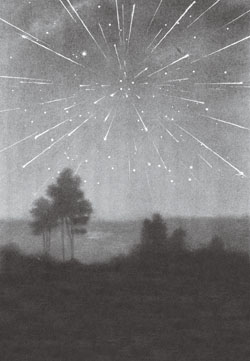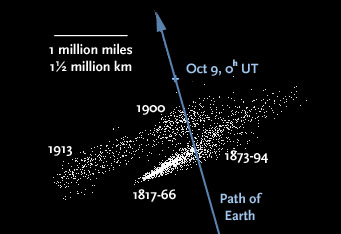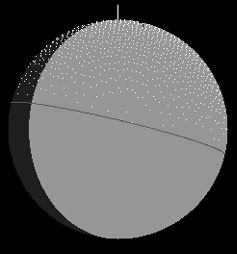I've had October 8, 2011, circled on my calendar for more than a year. That's how long I've known that the little-known Draconid meteor shower is predicted to put on an over-the-top performance.

The Draconid meteor storm of October 9, 1933, was witnessed all across Europe. Formerly called the Giacobinids, the shower appears to radiate from a point near in the head of Draco (a little to the lower right of the radiant portrayed here). This painting appeared in the 1959 edition of Larousse Encyclopedia of Astronomy.
Lucien Rudaux
Usually this shower delivers no more than 10 to 20 meteors per hour at its peak. However, as I mentioned last October, meteor specialists estimate that this year's Draconid rates could top 600 per hour — that's 10 per minute — under ideal viewing conditions. A recap of the various predictions is here. Click here to learn more about the Draconids and their checkered history.
These meteors are caused when Earth collides with bits of debris shed by periodic comet 21P/Giacobini-Zinner (and that's why this shower used to be called the Giacobinids). The comet has a 6½-year-long orbit that periodically carries it near Jupiter. Ordinarily, celestial dynamicists would expect the planet's powerful gravity to scatter anything in its vicinity into varying and unpredictable orbits. But they believe that a a stream of particles, ejected in 1900, is still largely intact, and Earth will sideswipe that river of rubble on Saturday.
In fact, the prospects for a really big show are good enough that international teams of scientists will take to the sky aboard two Falcon 20 aircraft to record the event. On one, the observers will be coordinated by Jérémie Vaubaillon of Paris Observatory's Institut de Mecanique Celeste et de Calcul des Ephemerides (IMCCE). The other will carry a research team led by Pavel Koten (Ondrejov Observatory). These are the first such airborne campaigns organized by European scientists.

On October 8, 2011, Earth will pass through several streams of particles ejected over the past 200 years by Comet Giacobini-Zinner.
J. Vaubaillon & others
"The idea is to have the two aircraft fly together over Scandinavia (mainly Finland), separated by 100 km," Vaubaillon explains on his website. "We will put as many cameras as possible (and allowed) in each plane and measure the flux of particles, the orbit of the meteoroids (in order to derive their specific origin), and meteor spectra (in order to know their chemical composition). Much is expected from such a unique campaign!"
Meanwhile, weather permitting down below, Peter Jenniskens (SETI Institute) and Michael Gerding of the Leibniz Institute for Atmospheric Physics will observe the Draconids with a resonant potassium lidar from Kühlungsborn, Germany. Japanese researchers plan to watch the sky show from Maidanak Observatory in Uzbekistan.
Best guess is that the dramatic peak will last only a few hours, centered at about 20h Universal Time. Those of you handy with time conversion can see that this peak is poorly timed (4 p.m. EDT, 1 p.m. PDT) for North Americans. European observers definitely have the best seats, despite interference from a waxing gibbous Moon.

White dots denote where meteoroids from comet 21P/Giacobini-Zinner can impact the Moon on October 8th. The best time to watch for impacts through a telescope is one or two hours after the predicted peak, around 21h to 22hUniversal Time.
P. Gural / J. Vaubaillon
Still, Jenniskens encourages you to look anyway during the day on Saturday. "Use binoculars looking 10° to 40° elevation away from the Sun (toward north) to spot bright Draconids from 19h to 21h UT," he suggests. "In the hours after the shower, telescopic observers might find it interesting to watch for possible lunar impacts in the sliver of darkness on the Moon near the north pole." (Make sure you identify which pole is which in your eyepiece.)
Coincidentally, the International Observe the Moon Night also falls on October 8th.
Jenniskens has assembled a rich array of details and plans on his team's website. If you've got time, check out the live (but intermittent) webcast planned for a few hours before, during, and after the shower's peak.
 5
5









Comments
Dave GIll
October 7, 2011 at 1:13 pm
I saw a bright meteor this morning - 10:42 UT - below the pole going E to W. Observed near Canton, OH. I have not looked at a chart to see if that puts the radiant in the right neighborhood or if this is a sporadic.
You must be logged in to post a comment.
Jim bugh
October 7, 2011 at 6:21 pm
I cannot believe how great this site is! I just found it after reading the november issue. For some reason, I could not find before but it will be visited every day now!
You must be logged in to post a comment.
Rahul Zota
October 8, 2011 at 4:11 am
Today at night our local astronomical club is preparing to watch this meteor shower. We will also try to capture in camera. Our club is located in Bhuj (India) which in the western part of India so we hope we'll see many fine meteors between 10:30pm to 11:30pm local time!
You must be logged in to post a comment.
Scott
October 8, 2011 at 12:44 pm
My father was in the Merchant Marines at the end of WWII and witnessed the Giacobini meteor storm in October 1946 from his oil tanker Canon Bay while in the Pacific. He was called to the deck by a friend and for several hours saw the sky filled with bright meteors which were in every part of the sky at any given moment! It was hard for me to believe this was even possible until I witnessed the same thing with the Leonid meteor storms of 1999-2000. I'm getting my binoculars and going out to check the daytime sky now!
You must be logged in to post a comment.
JIM GASSER
October 8, 2011 at 6:40 pm
I looked with binoculars and also have been looking at the lunar terminator. Kinda brutal staring at either one. Did not see any impacts or daytime meteors. To see a daytime meteor it would need to be very bright. I have seen Venus many times in the daytime at approx mag. -4, but that would be a very very bright meteor!!
You must be logged in to post a comment.
You must be logged in to post a comment.